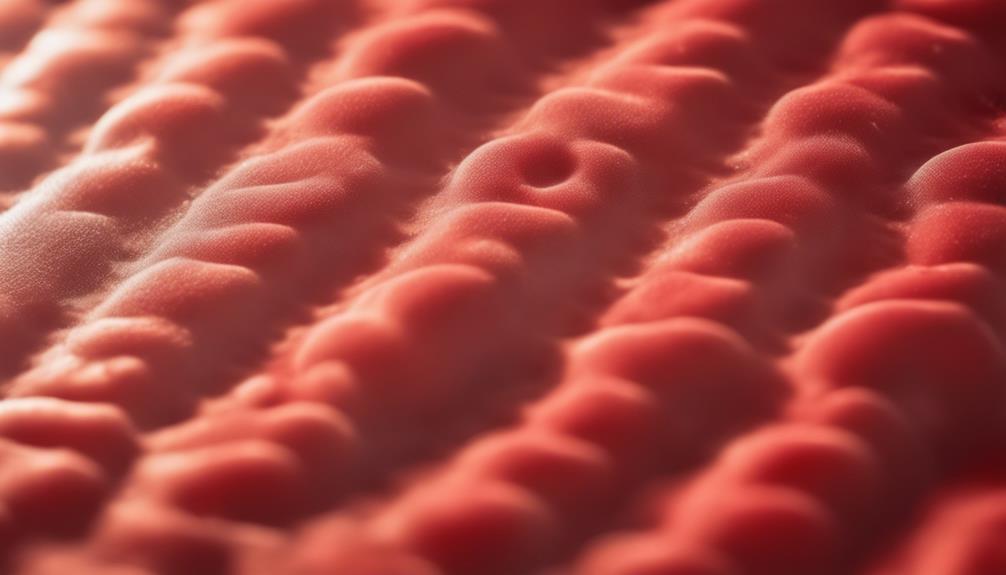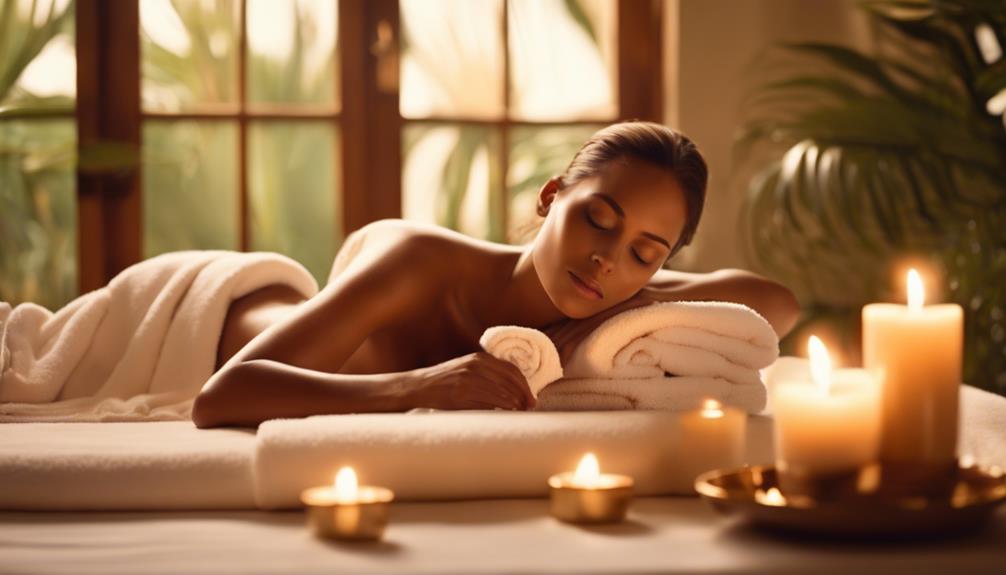So, you've just tanned, feeling fabulous, but now you've got an itch that just won't quit, huh? Post-tan itchiness usually comes from dry skin after sun or tanning beds, or maybe you're allergic to a product's sneaky ingredients. Overdoing it can also irritate your skin and leave you scratching. To tackle this annoying problem, keep your skin hydrated with moisturizer, and consider taking cool showers instead of hot ones. Want to learn about some quick home remedies to ease that itch, or even when to call in a pro? Stick around, friend!
Key Takeaways
- Post-tan itchiness is often caused by UV exposure, which dries out the skin and reduces moisture levels.
- Allergic reactions to tanning products, particularly fragrances and preservatives, can lead to redness and persistent itching.
- Maintaining a regular moisturization routine before and after tanning helps prevent irritation and skin tightness.
- Cool showers and soothing remedies like aloe vera or oatmeal baths can provide immediate relief from itchiness.
Causes of Post-Tan Itchiness
After tanning, you might experience itchiness due to the drying effects of UV exposure on your skin. It's like your skin's been sunbathing and forgot to drink water! Those UV rays can zap moisture, leaving your skin feeling tight and scratchy.
Plus, if you've been in a tanning bed, that hot environment can make things worse by trapping sweat, leading to heat rash. You might notice some raised bumps or redness, too—yikes! Overdoing it can really irritate your skin, making it cry out for relief.
Allergies to Tanning Products

Experiencing allergies to tanning products can lead to uncomfortable itching, redness, and rashes that dampen your tanning experience. You might think you've found the perfect lotion, but then bam! Your skin feels like it's on fire.
Fragrances and preservatives in these products can be sneaky culprits, triggering reactions you didn't see coming. And let's not forget those botanical extracts; they might sound natural but can still irritate sensitive skin.
If you're scratching like a cat on a hot tin roof, it's time to reassess what you're using. Keeping track of your products and knowing your triggers can help you enjoy that sun-kissed glow without the annoying aftermath. Who needs that drama, right?
Effective Prevention Techniques

To enjoy a smooth tanning experience and minimize itchiness, it's important to adopt effective prevention techniques that keep your skin healthy and comfortable.
First things first, always moisturize before and after tanning. Seriously, your skin will thank you!
You might also want to take it easy with your tanning sessions, gradually building up that bronzed glow instead of going all in at once.
And hey, using hypoallergenic tanning lotions can save you from those annoying allergic reactions.
If you start feeling uncomfortable, take a break from the UV rays. Remember, your skin isn't a superhero; it needs care too!
Identifying Tanning Bed Rash

Recognizing the signs of a tanning bed rash is essential for prompt treatment and prevention of further irritation. If you've just stepped out of the tanning bed and notice something off, keep an eye out for these telltale signs:
- Raised bumps on your skin
- Redness or irritation around the area
- Itching that just won't quit
Don't ignore these signs! They could mean your skin's had enough UV exposure.
If your symptoms hang around for more than five days, or if they get worse, it's time to call in the pros.
Managing Itchy Skin

Managing itchy skin after tanning requires immediate attention to soothe discomfort and promote healing. First things first, stay cool! A cool shower can work wonders, but don't crank it up to hot—that'll just make it worse. Moisturizers are your friends, especially those with aloe vera or oatmeal. They'll help hydrate that dry skin and ease the itch.
Check out this handy table for quick tips:
| Action | What It Does | When to Use |
|---|---|---|
| Cool shower | Reduces itch and inflammation | Right after tanning |
| Apply moisturizer | Soothes and hydrates | Daily, post-tan |
| Use aloe vera | Calms irritated skin | As needed |
| Stay hydrated | Keeps skin moist | Throughout the day |
Stick to these steps, and you'll be on your way to comfort in no time!
Remedies for Relief

Finding effective remedies for relief from post-tan itchiness can greatly improve your comfort and skin health. You don't have to suffer in silence!
Here are some quick fixes to help soothe that annoying itch:
- Slather on aloe vera: It's cooling and super hydrating—your skin will thank you!
- Use a fragrance-free moisturizer: This can lock in moisture and keep your skin soft.
- Take a cool shower: It helps calm the itch, but skip the hot water, or you'll just make it worse!
With these remedies, you'll be back to enjoying your tan without the itch in no time!
When to See a Doctor

Experiencing persistent itching or unusual skin reactions after tanning should prompt you to seek medical advice.
If you've scratched so much that your skin looks like a war zone, it's time to call the doctor!
Redness, rashes, or bumps that stick around for more than five days are signs something's not right.
Got oozing or fever? That's a definite red flag!
And hey, if you've got a family history of skin cancer, don't play around—get checked out.
You deserve to enjoy your tan without the itchiness drama!
Remember, your skin's your biggest organ, so treat it well.
Trust your gut; if something feels off, don't hesitate to get professional help.
Better safe than sorry, right?
Frequently Asked Questions
Can Diet Impact Skin Reactions After Tanning?
Yes, your diet can impact skin reactions after tanning. Consuming anti-inflammatory foods, staying hydrated, and avoiding allergens can help maintain skin health, reducing the likelihood of irritation and enhancing your overall tanning experience.
Is Itchiness Common for First-Time Tanners?
If you're a first-time tanner, you might find your skin feeling a bit prickly or restless afterward. It's common, often due to dryness or irritation. Just remember to moisturize, and you'll likely feel better soon.
How Long Does Post-Tan Itchiness Typically Last?
Post-tan itchiness usually lasts a few hours to a couple of days. It often depends on your skin type and how well you moisturize. Keeping your skin hydrated can help reduce discomfort considerably.
Can Certain Medications Increase Tanning Side Effects?
Yes, certain medications can increase tanning side effects. If you're taking medications that cause photosensitivity, you might experience enhanced irritation, redness, or itchiness after tanning. Always check with your doctor about potential interactions before tanning.
Are There Safe Tanning Options for Sensitive Skin?
If you have sensitive skin, consider using hypoallergenic self-tanners or airbrush options. Always patch-test products beforehand, and keep your skin moisturized to prevent irritation. Consult a dermatologist for personalized recommendations and safe practices.
Conclusion
So, next time you're itching after a tanning session, remember you're not alone!
Did you know that about 30% of people experience skin irritation from tanning products? Yikes!
But don't worry, with the right prevention and soothing methods, you can keep that post-tan itchiness at bay.
Just be mindful of what you put on your skin and listen to its needs.
Enjoy the sun and stay comfy—your skin will thank you for it!










